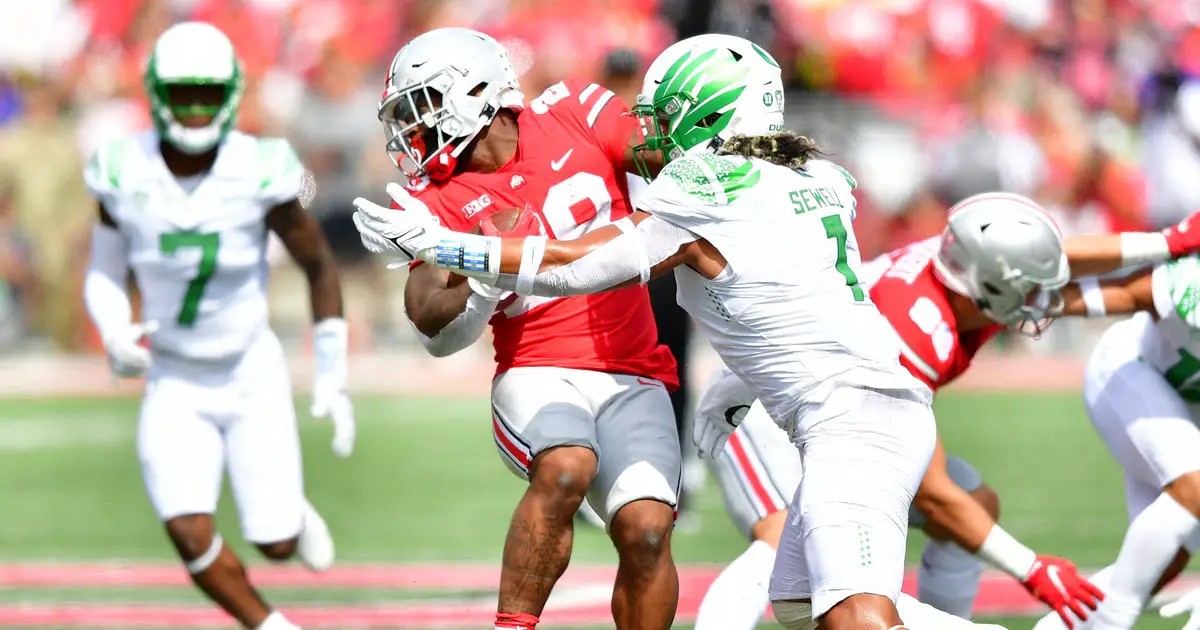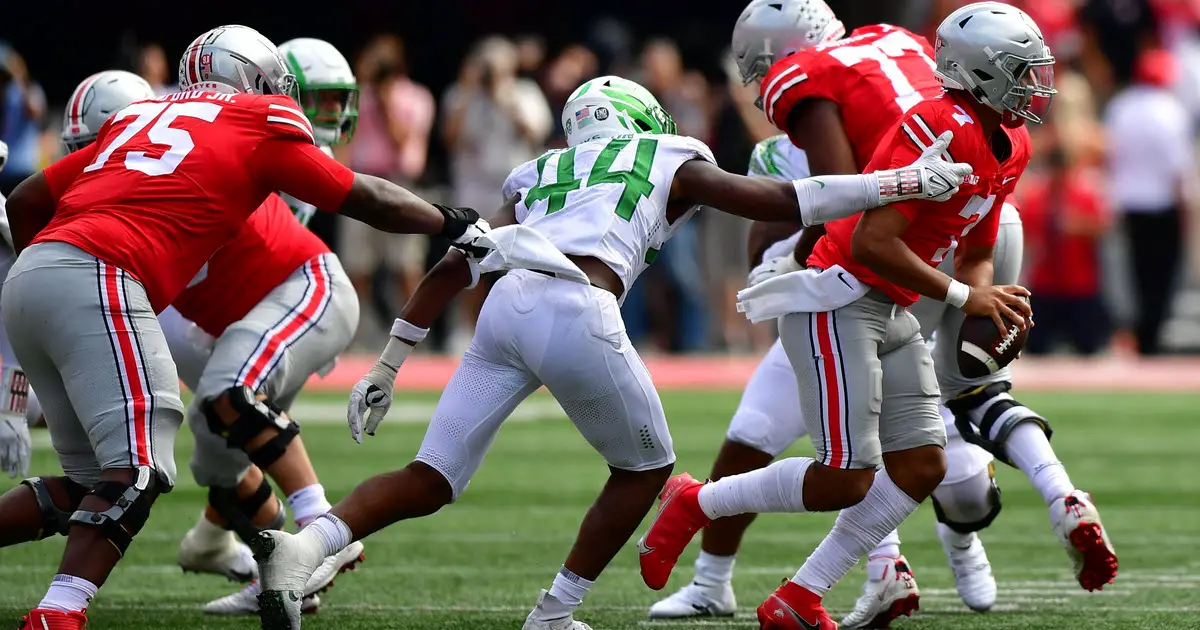Oregon’s victory over Ohio State last Saturday was not only a major win for the Oregon Ducks but also a massive win for the Alliance between the Pac-12, ACC and B1G. One of the biggest problems with the Alliance has been the lack of a premier program from the Pac-12. The B1G has Ohio State, and the ACC has Clemson, but until last week, the Pac-12 had no big time national program. Oregon was, at best, a second-rate power.
Oregon previously held the best non-conference win of any Pac-12 team — over B1G runner-up Wisconsin in the 2020 Rose Bowl — but that wasn’t a win over the premier power of the B1G, or of any other Power Five conference. The 2020 Rose Bowl victory was good stepping stone for Oregon but simply not good enough to raise Oregon’s or the Pac-12’s statuses nationally.
Everything changed with Oregon’s win over Ohio State. Oregon took out the super power of the B1G, and they didn’t just scrape by. They showed they were better than Ohio State. This Oregon team proved they were Ohio State’s equal and, moreover, that the top of the Pac-12 was the equal to the B1G and the ACC. The Pac-12 may finally have its super team.

Noah Sewell and the Oregon Ducks defense stifled Ohio State’s run game.
Outside of Oregon, and perhaps UCLA, the Pac-12 doesn’t look good. Currently, the Pac-12 is 10-10 against non-conference opponents, and many of those opponents have been FCS programs, which makes that winning percentage even more underwhelming. Washington actually lost to an FCS school in Week 1.
However, the Pac-12 doesn’t have to be good top-to-bottom (and frankly, the Pac-12 looks pretty weak on the whole so far this year). The ACC has not been a strong football conference overall, either, but Clemson alone has kept the conference relevant.
Long Term Plans
The Oregon-Ohio State showdown put on full display what this Alliance will be able to produce with priority scheduling. It wasn’t the only Pac-12-B1G cross-conference game on Saturday, as Michigan and Washington squared off in prime-time. That game ended with Michigan soundly defeating Washington in a game that looked like it should have been played in the 1980’s.
Pac-12 Commissioner George Kliavkoff was even seen in a private box with B1G Commissioner Kevin Warren during the Oregon-Ohio State Game. Following Oregon’s victory, Kliavkoff took the relatively short trip to Michigan to be present for the Michigan-Washington game, using it as an opportunity to showcase the Alliance he had played a key role in creating.
In terms of television ratings, the Alliance scored a huge win. Oregon at Ohio State captured the top spot in Week 2, with 7.7 million viewers. In second place was Washington at Michigan at 4.7 million, and coming in third was Colorado and Texas A&M with 4.5 million viewers. This was followed by a big drop off in viewers. This puts three Pac-12 teams and two B1G teams in the top three spots for Week 2.
If this trend continues, the Alliance will be in a strong position to negotiate better terms for all three conferences when the time comes for new contracts. Kliavkoff has also inferred that the long term plan for the Alliance is to sprinkle these cross-conference games throughout the season. If done correctly, this could create interesting match-ups that attract prime time viewing all season long.
Furthermore, if these games are planned just before the season begins, it could create even more interesting match-ups between equally talented teams and foster new rivalries. This would be a major deviation from how schedules are currently created — years, if not decades, in advance, with no way of knowing how good the competing teams may be.
The Alliance and Playoff Expansion
On-field success will increase the clout and influence the Alliance will have on future policy decisions in the NCAA. Currently, the Alliance formed as a voting block to counter the ever-growing super power of the SEC. However, there is a chance that if the Alliance is able to field more combined influence than the SEC, it could be the Alliance, rather than the SEC, that dictates what the Playoff expansion looks like and how to distribute those media rights.

Bradyn Swinson sacks CJ Stroud in the 4th quarter in the best game on TV in Week 2.
This Alliance could change the formula for getting into the College Football Playoff if given the opportunity. Currently, the only feasible way of getting into the Playoff is to schedule the easiest out-of-conference opponents to ensure, at worst, a one-loss season. This has at least been the formula for the SEC and Big-12. Clemson has had the benefit of playing in an overall weak conference, especially given Florida State’s and Miami’s declines.
Big games that bring in big audiences are just the first step in building the Alliance into a power of change within college football. The Alliance has a broader outlook than just football, but every commissioner knows that football is the driving force that makes other college sports financially possible. For the Alliance to meet their goals, the Pac-12, the B1G and the ACC all have to field premier football teams. Right now, Oregon is that team in the Pac-12.
To date, there hasn’t been a single game scheduled by the Alliance. All these cross-conference match-ups were planned long in advance, but that shouldn’t stop Kliavkoff from promoting just what this Alliance could do in the future. Just think of the possibility of Clemson at Autzen or Oregon at Happy Valley? Would Oregon win? Maybe, but wouldn’t it be fun to find out?
David Marsh
Portland, Oregon
Top Photo By Tom Corno
 Andrew Mueller, the FishDuck.com Volunteer Editor for this article, works in higher education in Chicago, Illinois.
Andrew Mueller, the FishDuck.com Volunteer Editor for this article, works in higher education in Chicago, Illinois.
Related Articles:
Oregon Enters Playoffs Better Off Than Last Year
Will The Coaching Carousel Kill Oregon's CFP Chances?
The Playoff Formula Hasn't Changed
Oregon Aims to Bury Dawgs, Punch Playoff Ticket in Rivalry Clash
Huskies Are the New Beavers, Stay In Your Lane Kiffin, and the Civil Apple Cup War
Oregon Football: The X-Factor Vs. Washington

David Marsh is a high school social studies teacher in Portland, Oregon. As a teacher he is known for telling puns to his students who sometimes laugh out of sympathy, and being both eccentric about history and the Ducks.
David graduated from the University of Oregon in 2012 with Majors in: Medieval Studies, Religious Studies, and Geography. David began following Ducks Football after being in a car accident in 2012; finding football something new and exciting to learn about during this difficult time in his life. Now, he cannot see life without Oregon football.

